Foxes are often viewed as feisty, aggressive, and combative creatures. When put in a dangerous stance, they will not hesitate to attack and may even kill anyone that comes in their way. This is especially true when other creatures try to take away their food, offspring, and habitat or when they are cornered and placed in a threatening situation. But do you know that despite their gladiatorial traits, they can still be overpowered by other animals, making them a tasty meal?
Here are the 9 natural fox predators:
- Bears
- Mountain Lions
- Owls
- Wolves
- Eagles
- Leopards
- Coyotes
- Humans
- Other Fox Species
In the succeeding sections of this article, discover more of these natural predators by learning about their appearance, lifespan, weight, size, diet, place of origin, and characteristics. Other than that, find out if badgers, dingos, lions, and tigers enjoy eating fox meat!
Table of Contents
9 Natural Fox Predators
1. Foxes
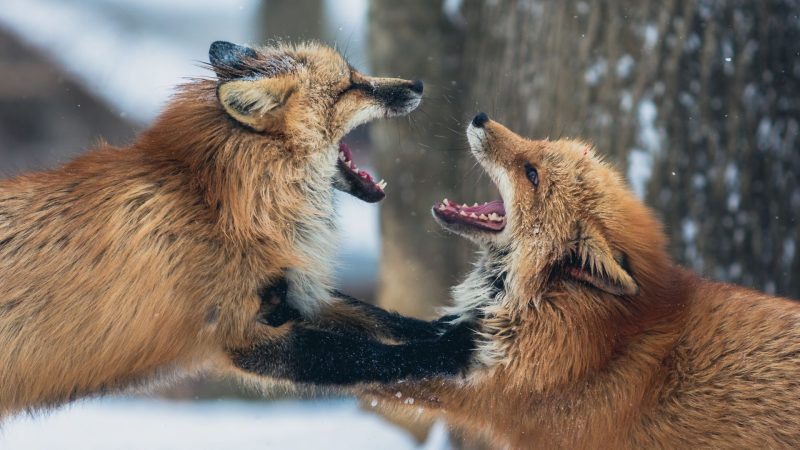
Do Foxes Eat Foxes?
Foxes have the tendency to eat other fox creatures. Although it only occurs in rare instances, devouring the flesh and meat of their own kind is still possible. This can happen if they are experiencing extreme hunger and starvation and left with no choice but to eat of their kind. They might snitch and attack a fox puppy or kit from another den.
Other than that, when a fox fights with another fox, the victor may lash out and devour the other. Even though foxes are solitary beings most of the time, they may still pick a fight with animals of their kind and eat them after.
- Appearance: Their face structures are triangular in shape, with upward-pointing ears, an elongated rostrum, a noticeable set of canines, and long, bushy tails. Foxes have claws that partially retract as they walk on their toes, and their muzzles and forelimbs have whiskers. The color of the fox may vary depending on the species. Reddish-brown, gray, white, and sandy brown are common colors, while their undersides are usually white. These hues become darker and richer during the cold season, but they become lighter in shade when the weather warms up. It could potentially change as the fox grows older.
- Lifespan: They can live in the wild for 2 to 6 years, but they can live for up to 14 years when held captive.
- Size: The size may depend upon the fox species. Their average height is 14 to 20 inches, while their average length is 18 to 35 inches. On the other hand, the whiskers on their muzzles are 3 ⅞ to 4 ⅜ inches long, while those in their forelimbs are usually 1 ⅝ of an inch.
- Weight: Their weight will also depend on their breed. The biggest foxes have an average weight of 9 to 19 ¼ pounds, while the smallest ones typically weigh 1 ½ to 3 ½ pounds.
- Diet: They are omnivores that eat small animals such as rabbits, mice, voles, birds, frogs, and earthworms, as well as fruits and vegetables like berries, corn, and barley. Foxes will also devour provisions left in garbage bins, pet food that is left uneaten, and various poultry products.
- Place of Origin: These creatures are natives of European, temperate Asian, and African continents, and in the present day, most of them are still inhabiting North America.
- Characteristics: They are known to be solitary beings, and they tend to live in small groups. When they hunt, they perform a distinct pouncing movement by making a giant leap with their hind legs and landing on their prey subsequently. They tear down their victims using their sharp canine teeth, and the excess food is usually brought to their habitat and hidden under soil, leaves, and snow. Their kind also has the ability to run, jump and climb fast.
2. Bears

Do Bears Eat Foxes?
Bears are omnivorous creatures, so they both eat meat and vegetation. Although their diet consists of 85% plants, they also devour small animals like foxes because of their opportunistic trait. This is especially true when it becomes difficult for them to hunt for larger animals. Foxes are incomparable to bears’ size, strength, and dexterity, so they are regarded as an easy catch.
- Appearance: They have large bodies with body hairs that are shaggy and thick. Each foot has five digits and non-retractable claws, which they use in digging. The soles of their feet are hairless except for polar bears, which need hairs due to the cold weather on their habitats. They have small and round ears, long and elongated snouts, bulging lips, short and chunky tails. Their skulls are elongated, have tensile jaw muscles, and an unspecialized set of canine teeth. Foxes have typical colors: black, brown, cinnamon, bluish-gray, white, and blond.
- Lifespan: If they are in the wild, they can live for up to 25 years. But when held captive, they can live for up to 50 years.
- Size: The biggest bear species have a total length of 7 feet, 10 inches to 9 feet, 10 inches, while the smallest bear breeds are at 40 to 55 inches.
- Weight: The heaviest bears weigh 770 to 1,500 pounds, while the lightest ones weigh 55 to 145 pounds.
- Diet: They are mostly omnivores, but they also feed on animal meat. Bears eat plant leaves and roots, fruits such as berries, fish, insects, fresh meat, and carrion.
- Place of Origin: The modern species appeared five million years ago in the Eurasian regions. They subsequently spread to different continents, including North America, South America, Europe, and Asia.
- Characteristics: They are regarded as solitary beings. But they can also be found with other bears during the mating and breeding season from May to July of every year. They communicate through vocal and non-vocal cues, such as grunting, huffing, chuffing, snorting, tongue-clicking, growls, bellows, pulsing sounds, and lip-popping. Some bear species hibernate during the winter and can survive without eating, drinking, or defecating during the said period.
3. Mountain Lions

Do Mountain Lions Eat Foxes?
Mountain lions feed on foxes. As a matter of fact, they are one of the top predators from the family of big cats that prey on the said creatures. Like the foxes, mountain lions are also nocturnal in nature, so they hunt and search for their food during dusk. Thus, it is easy for them to attack and forage foxes due to their identical schedule for activity and movement.
- Appearance: They are cats that are larger in size but possess slender body structures. Their limbs are typically short, but their feet have a broad base which consists of four digits on the back feet and five on the front feet. They have a small mandibular structure which can be very powerful due to their carnassial teeth, canines, and incisors. Their color ranges from yellowish-brown to grayish-brown with yellow and leathery stomachs, whitethroats and chests, pink noses, and black markings on the mouth, behind ears, and tips of tails.
- Lifespan: They can live for 8 to 13 years in the wild and up to 21 years in captivity.
- Size: From nose to tail tip, adult males have a length of 7 feet, 10 inches, while adult females are typically 6 feet, 9 inches. Overall, their measurement ranges from 4 feet, 11 inches to 9 feet.
- Weight: Adult males have an average weight of 117 to 220 pounds, while adult females usually weigh 64 to 141 pounds.
- Diet: They are carnivorous and will feed on other animals like foxes, coyotes, bobcats, squirrels, moose, mule, and white-tailed deers. Mountain lions attack their prey by biting the part below their skulls’ base and breaking their necks.
- Place of Origin: It is native to the American region, ranging from the Canadian Yukon to the Southern Andes of South America.
- Characteristics: They are fond of nocturnal hunting. Mountain lions stalk for prey during the nighttime, and when they find one, they will deliver a fatal blow on the victim’s spinal cord, usually below the base of the skull. They are solitary creatures with secretive traits and can easily adapt to ever-changing environments that allow them to survive from varying threats. They tread through their home range in a zigzag manner, grabbing any opportunity for available cover when hunting for food.
4. Owls

Do Owls Eat Foxes?
Owls eat foxes. They are regarded as raptor creatures because they can grasp and seize their prey when they forage for food. Owls are one of the fiercest animals in the wild as they can quickly strike and grapple their opponents through their sharp claws. Thus, attacking and capturing small mammals like foxes are easy for them.
- Appearance: They have flat and round face structures with small, hook-like beaks and large, forward-looking eyes. These beaks are naturally pointing downward, which they typically use when pecking. Their plumage blends well with their environment, making it an effective camouflage in the wild.
- Lifespan: They can live in the wild for 9 to 13 years, but they can live for up to 30 years if held in captivity.
- Size: Their length ranges from 5 to 28 inches, and their wingspan can be 1 to 6.6 feet.
- Weight: Their average weight ranges from 1.1 ounces to 10 pounds.
- Diet: They are nocturnal hunters and primarily eat small mammals such as rabbits, foxes, skunks, rodents, birds like ducks and quails, fish, reptiles, amphibians, and insects. Owls utilized the ‘sit-and-wait’ method, which is done by sitting patiently at a distance and instantly striking an available prey with the use of their talons.
- Place of Origin: They are found in almost all of the continents, except for the cold regions of Antarctica.
- Characteristics: They are active as dusk or twilight starts, as this is the time when they hunt for food. Owls have the ability to outsmart their prey with the use of their stalking skills and surreptitious hunting techniques. Their senses of sight and hearing are overly sensitive, enabling them to perceive even the slightest vibration from their prey. They fly silently in the air and produce distinct sounds as they snap their bills, clasp their wings, and vocalize through unique rhythms, timbres, and pitches.
5. Wolves
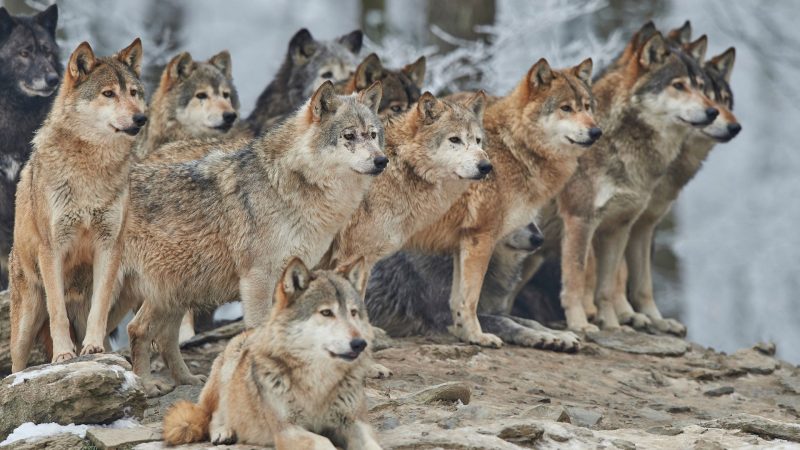
Do Wolves Eat Foxes?
Wolves can eat foxes. Despite the fact that they belong to the same family, wolves can be very vicious, especially when they are extremely hungry. When these animals are experiencing intense starvation, they can devour anyone that may come in their way, including smaller creatures like foxes. They are opportunistic and aggressive, so they may prey on any available flesh if their usual prospects are not available.
- Appearance: They have slender body structures, short ears, broad snouts, long tails, and short torsos. Wolves also have large heads, triangular ears, powerful jaws, long muzzles, and strong sets of teeth that are ideal for chewing and masticating. Their backs are somewhat sloped, and their necks are excessively muscled, but their legs are moderately long.
- Lifespan: They can live for 8 to 13 years in the wild and 15 years in captivity.
- Size: They are 41 to 63 inches in length, with tails measuring 11 to 20 inches. At shoulder height, they are 31 to 33 inches.
- Weight: Their average weight is 88 pounds. The smallest weight is noted to be 26 pounds, while the heaviest one recorded is 175 pounds.
- Diet: They are carnivorous creatures that prefer to eat hoofed animals, such as bison, moose, elk, and deer. But they can also feed on smaller creatures like rodents, hares, and beavers.
- Place of Origin: They originated from the regions of Eurasia and North America.
- Characteristics: They are mostly considered social animals as they are typically seen in groups called packs. Wolves are territorial in nature, and these habitats are established depending on the amount of available prey. They mark these territories using scents from their feces, urine, and anal glands. Their mode of communication may range from vocal cues, odors, body postures, and tactile hints.
6. Eagles
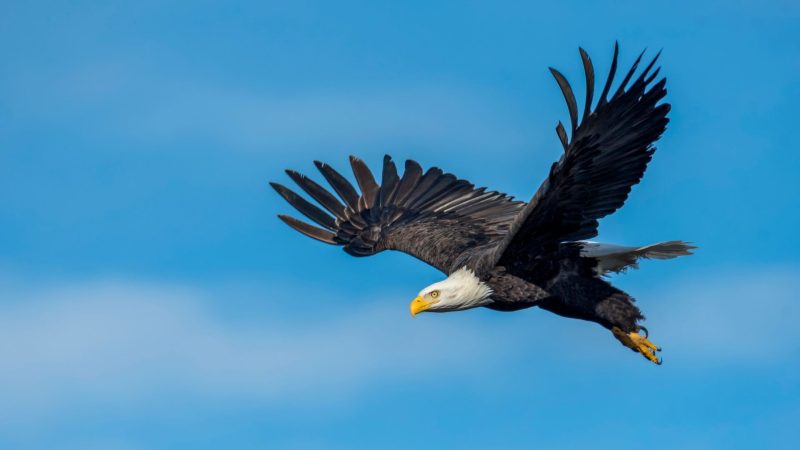
Do Eagles Eat Foxes?
Eagles may eat foxes, specifically the kits and pups. They don’t usually go for adult foxes due to the obvious disparity in size and weight. However, they can be very skillful in hunting young foxes due to their quickness in movement and sharp eyesight.
- Appearance: Eagles have large eyes with excellent acuity. They have giant, hooked beaks, which they use when pecking or ripping off their prey. Eagles have heavy heads, strong legs and talons, and powerful wings. They are typically dark brown to gray in color.
- Lifespan: They can live for 20 to 30 years in the wild.
- Size: Male bald eagles are usually 36 inches long with a wingspan of 2 meters, while female bald eagles are 43 inches in length with a wingspan of 2.5 meters.
- Weight: Male bald eagles may weigh 14 pounds, while female bald eagles may have a weight of 10 pounds.
- Diet: They are primarily carnivorous. Eagles feed mainly on fish, reptiles, rabbits, hares, grouse, amphibians, crabs, and other smaller birds and their eggs.
- Place of Origin: The majority of the 60 breeds of eagles originate from Africa and Eurasia.
- Characteristics: They have strong flight skills and depend mostly on live prey. Their quick grappling motion and very keen eyesight give them the capacity to seize any vulnerable victim. In killing their prey, they usually decapitate their heads. As to their mating habits, they are monogamous in nature and breed on the same nest every time they produce offspring.
7. Leopards
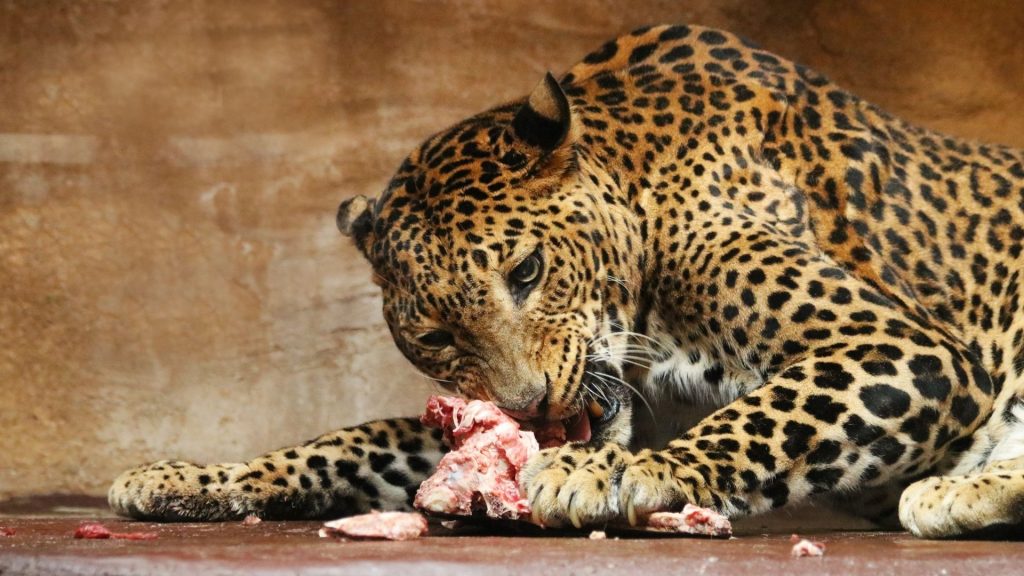
Do Leopards Eat Foxes?
Leopards eat foxes. They are one of the large cat family members that can feed on foxes when other preys are not available. A fox may escape from the wrath of leopards but know that the latter runs fast than the former. Thus, foxes can be caught by leopards without much effort and sweat.
- Appearance: Leopards’ eyes have round pupils. As to their bodies, they have pale yellow to dark gold in color that are filled with dark spots. Their underbellies are usually white with fur that are softer on the said part than the other body structures. They have tails that are typically shorter than their body length. Its tips are white in color.
- Lifespan: They can live for 10 to 12 years in the wild and up to 23 years in captivity.
- Size: Their length ranges from 2 feet and 11.4 inches to 6 feet and 5.2 inches, while their tails typically measure 2 feet and 2 inches to 3 feet and 4.2 inches.
- Weight: Male leopards may weigh 81.6 to 198.4 pounds, while female leopards may weigh 61.7 to 132.3 pounds.
- Diet: They are mainly carnivores and prefer to devour animal meat. The common prey of these creatures include foxes, jackals, bushbucks, cheetahs, genets, ungulates, and primates.
- Place of Origin: They are endemic in the vast majority of African regions.
- Characteristics: They are solitary but at the same time territorial. Leopards are active from nighttime until dawn to hunt and forage for prey. During the day, they stay and rest on rocks and tree branches. Other than that, they are adept at climbing trees, running at a considerable distance, and jumping vertically.
8. Coyotes
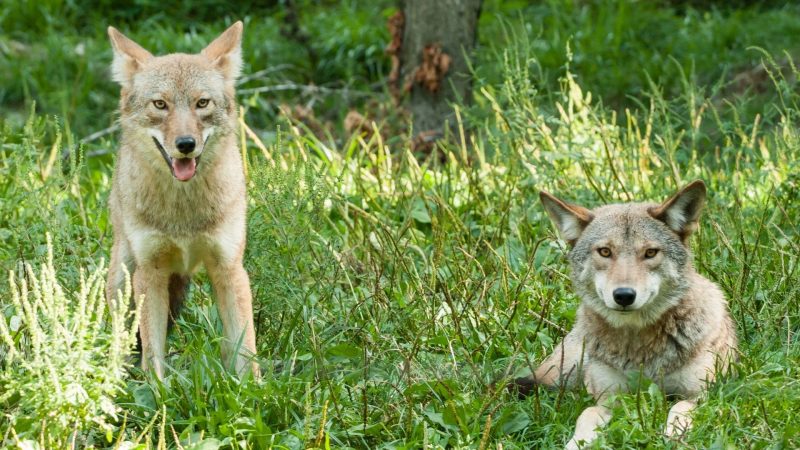
Do Coyotes Eat Foxes?
It is said that coyotes are natural enemies of foxes. So when these two creatures get an encounter, it will surely be a bloody one. Coyotes do not typically feed on foxes. But when there is a scarcity of food, or when they are forced to slay foxes in order to reduce their competitors, they will not hesitate to eat them after.
- Appearance: They have body parts that are yellowish-gray to grayish-brown in color. Their throats and underbellies are white, while the sides of their heads, muzzles, feet, and front legs are reddish-brown. They also have pointed ears, slender muzzles, round pupils, black noses, and drooping tails that have black tips.
- Lifespan: They can live for 6 to 8 years in the wild and up to 21 years if they are held captive.
- Size: Their average length is 29.53 to 39.37 inches.
- Weight: Their average weight is 15.42 to 46.26 pounds.
- Diet: They are carnivorous animals. Coyotes like to eat smaller creatures such as rabbits, ground squirrels, and mice. On some occasions, they would also feed on snakes, large insects, and birds. They prefer fresh meat, but in certain instances, they may eat decaying flesh of dead animals.
- Place of Origin: They are originally from North America.
- Characteristics: They are nocturnal creatures and loves to forage food at night. Coyotes do this activity either solitarily, by pair, or with the help of their family members. They communicate vocally through howls, squeaks, yelps, and distress calls. However, they can also relay a message through olfactory, visual, auditory, and tactile cues.
Related: Fox vs. Coyote | What’s Really in Your Backyard?
9. Humans

Do Humans Eat Foxes?
Humans may eat foxes. But they are an uncommon meal as their meat is somewhat tough and has a distinct smell. On the other hand, some people have the habit of hunting foxes and cooking them into an appetizing main course.
Frequently Asked Questions
Here are some of the frequently asked questions about fox predators:
Do Badgers Eat Foxes?
Badgers can eat foxes. They would invade a fox’s den and take away the kits if given the opportunity, most likely turning them into a tasty meal.
Do Dingos Eat Foxes?
Since dingos are fond of meat, they may eat foxes. This is not typically a common scenario, but when there is no other food available, and there is a chance to kill foxes, they will not hesitate and eat them after.
Do Lions Eat Foxes?
Lions also eat foxes, although not quite a lot. They prefer medium-sized animals like antelopes and zebras. But when the only available food source is smaller animals such as foxes, they will probably grab the chance and eat them.
Do Tigers Eat Foxes?
Tigers eat foxes. They are one of the largest creatures from the family of cats, and they have the power to devour smaller animals like foxes. This is especially true when the tigers are at the point of extreme starvation.
Summary
You may view foxes as creatures that are tough to beat but keep in mind that other animals are mightier than them. These predators will not hesitate to attack foxes to fill and satisfy their hunger. Foxes’ natural enemies will not even care if they grapple with kits or young foxes. In the wild, it is unquestionably a bloodbath.
List of Sources
Link, R. (2005). Living with Wildlife: Owls. Washington Department of Fish and Wildlife.
Bald Eagle. (2010). Connecticut’s Official State Website.
Mountain Lion. University of Kentucky.
